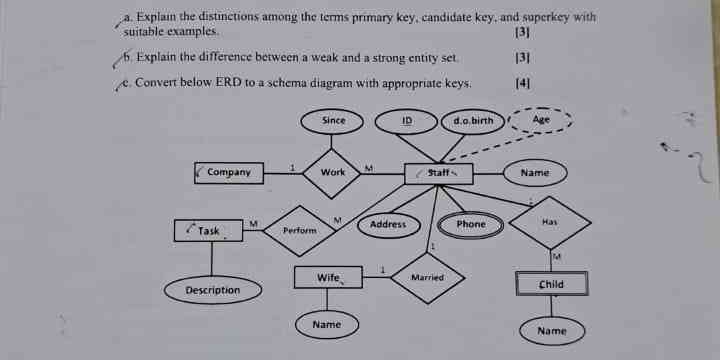a. Explain the distinctions among the terms primary key, candidate key, and superkey with suitable examples. b. Explain the difference between a weak and a strong entity set. c. Co... a. Explain the distinctions among the terms primary key, candidate key, and superkey with suitable examples. b. Explain the difference between a weak and a strong entity set. c. Convert below ERD to a schema diagram with appropriate keys.

Understand the Problem
The question is asking for explanations of key concepts in database design, specifically about keys in relational databases, and to convert an Entity-Relationship Diagram (ERD) into a schema diagram. It addresses primary keys, candidate keys, superkeys, and the difference between weak and strong entity sets, indicating it is focused on basic principles of database management.
Answer
A primary key is a chosen candidate key; a superkey can be any unique identifier. A weak entity relies on another key; a strong entity has its own. Schema links entities with IDs.
a. A primary key is a unique identifier for a table, selected from candidate keys. A candidate key is a minimal superkey, meaning no subset can uniquely identify a table record. A superkey is any set of attributes that can uniquely identify a record.
Examples:
- Superkey: (ID, Name), (ID, Address)
- Candidate key: (ID)
- Primary key: (ID)
b. A strong entity set has its own primary key, whereas a weak entity set does not and relies on a foreign key from another entity.
c. Schema:
- Staff (ID - Primary Key, Name, d.o.b, Age, Address, Phone)
- Company (Primary Key related via StaffID)
- Task (Description, StaffID - Foreign Key)
- Married (Wife, Husband)
- Child (Name, ParentName - Foreign Key)
Answer for screen readers
a. A primary key is a unique identifier for a table, selected from candidate keys. A candidate key is a minimal superkey, meaning no subset can uniquely identify a table record. A superkey is any set of attributes that can uniquely identify a record.
Examples:
- Superkey: (ID, Name), (ID, Address)
- Candidate key: (ID)
- Primary key: (ID)
b. A strong entity set has its own primary key, whereas a weak entity set does not and relies on a foreign key from another entity.
c. Schema:
- Staff (ID - Primary Key, Name, d.o.b, Age, Address, Phone)
- Company (Primary Key related via StaffID)
- Task (Description, StaffID - Foreign Key)
- Married (Wife, Husband)
- Child (Name, ParentName - Foreign Key)
More Information
Understanding keys is crucial for database normalization, ensuring data integrity and reducing redundancy.
Tips
A common mistake is confusing candidate keys with superkeys, as all candidate keys are superkeys but not vice versa.
Sources
- DBMS Keys: Primary, Foreign, Candidate and Super Key - Javatpoint - javatpoint.com
- Entity Relationship Model - WBUTHELP.COM - wbuthelp.com
AI-generated content may contain errors. Please verify critical information